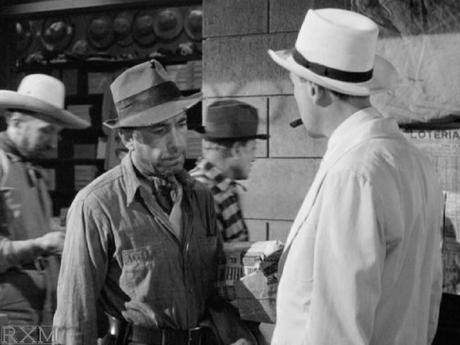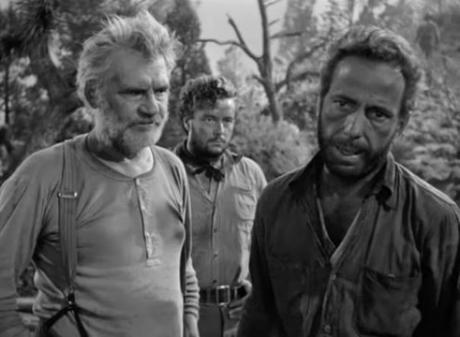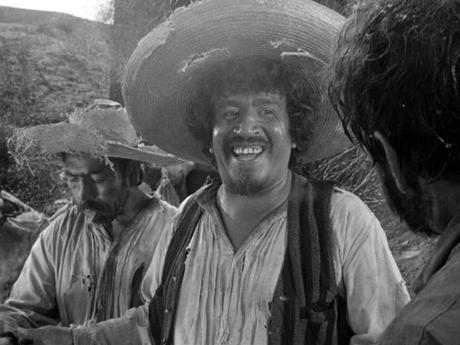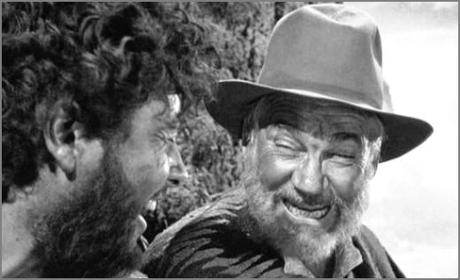 Humphrey Bogart (left) & John Huston in The Treasure of the Sierra Madre)
Humphrey Bogart (left) & John Huston in The Treasure of the Sierra Madre)A vagrant in a battered hat, raggedy clothes and unshaven visage comes up to a tall lean man in a white suit and matching white hat. The tall lean man, who is smoking a stogie and has a long inquisitive face, is reading a newspaper as he pauses to get his dusty shoes shined. Begging the man’s pardon, the shabbily dressed vagrant screws up enough nerve to ask the tall lean gentleman if he could help a fellow American who’s down on his luck.
Three times the vagrant pesters the tall lean man for a buck. After the last time, the tall lean man gives him two coins instead of one and simultaneously charges him with the responsibility of finding his own way in the world, but without his monetary aid.
As luck would have it, the vagrant runs into another fellow American down on his luck. Knowing full well that misery loves company, the twosome join forces to pool whatever wits and resources they still have to try and make a go at it in Tampico, Mexico.
The mysterious B. Traven’s 1927 novel The Treasure of the Sierra Madre about three prospectors panning for gold in the rugged Mexican backlands served as the basis for this classic Warner Brothers motion-picture depiction.
Produced by Henry Blanke, the film was written and directed by Academy Award winner John Huston (The Maltese Falcon), who lived for a time in Mexico and appears as the white-suited American continually hit upon for assistance. Co-starring Huston’s veteran actor father, a toothless Walter Huston, in an Oscar-caliber performance as the lanky old-timer Howard, The Treasure of the Sierra Madre is an epic morality tale about the dangers of too much greed and too little foresight.

Desperate for dough, the two down-and-outers, Fred C. Dobbs (a mean and ornery Humphrey Bogart, in one of his best “rabid dog” roles ever) and Bob Curtin (a stocky but game Tim Holt), team up with the aforementioned Howard, an expert on past prospecting ventures, upon hearing him talk up a storm about his exploits in a Tampico flophouse. Howard knows a thing or two about prospecting, and even more about human nature.
After Dobbs gets lucky with a winning lottery ticket, the trio sets off for the Sierra Madre mountains. Seeing the agile old geezer traverse steep terrain with precious little effort, Dobbs wonders if he isn’t part goat. With Howard’s help, they hit pay dirt; but soon after, the men are forced to confront other crises, among them a fourth vagrant named Codie (Bruce Bennett), who’s just itching for a piece of the action. When Codie is killed by bandits and Howard gets whisked off by the locals for saving a boy’s life, Dobbs and Curtin are left to fend for themselves.
Eventually succumbing to gold fever, Dobbs tries to eliminate the competition in typical delusional fashion. He meets his fate at the hands of those same Mexican bandits, one of whom, a nervous fellow known as “Gold Hat” (newcomer Alfonso Bedoya — forever fidgety, thanks to Huston’s non-direction), earlier uttered the famous line about not having to show “any stinking badges.”

The movie is hard to classify. Basically, it’s part Western and part film noir. For an action-adventure yarn, however, this adult drama emphasizes (wonder of wonders) character development over elaborate special effects – in particular, that of the reckless Dobbsey. His descent into a hellish, fiery furnace is a trifle too literal at times, but otherwise this is fine entertainment the whole family can enjoy. It’s amazing what the talented Bogart could do with this two-dimensional creature. By humanizing Mr. Dobbs, one almost feels sorry for the man, which is probably the right feeling to have in these circumstances.
Tim Holt, so easily affronted and forceful in Orson Welles’ The Magnificent Ambersons (1942), is equally memorable for revealing Curtin’s warm and tender side (the touching letter reading episode, for instance). He’s joined by his old man, veteran cowpuncher Jack Holt, who can be seen briefly in the flophouse sequence.
And last but not least, there’s the great Walter Huston, sounding off with that infectious laugh of his, as well as doing that funny little dance that Billy Crystal so admired (and stole from) for his comedic version of the story (see City Slickers II: The Legend of Curly’s Gold). Huston is the picture’s moral center, the iron rod thrust into the dirt and the fellow you want by your side when the going gets tough — and brother, does it ever get tough!

One can’t fail to mention composer Max Steiner’s powerful film score, a major character in itself. Others in the strong cast are Barton MacLane as McCormick, young Robert Blake as the boy who sells Bogie the winning ticket, Arturo Soto Rangel as El Presidente, Manuel Donde as El Jefe, José Torvay as Pablo, Margarito Luna as Pancho, Pat Flaherty, and (most controversially) Ann Sheridan as a streetwalker, who had allegedly participated in the production, but which has never been confirmed with absolute certainty.
The ending is a masterpiece of cinematic irony and the film is noteworthy, too, for not having the spoken Spanish subtitled. Regardless, you can figure out what they’re talking about through their actions and gestures.
Copyright © 2016 by Josmar F. Lopes

